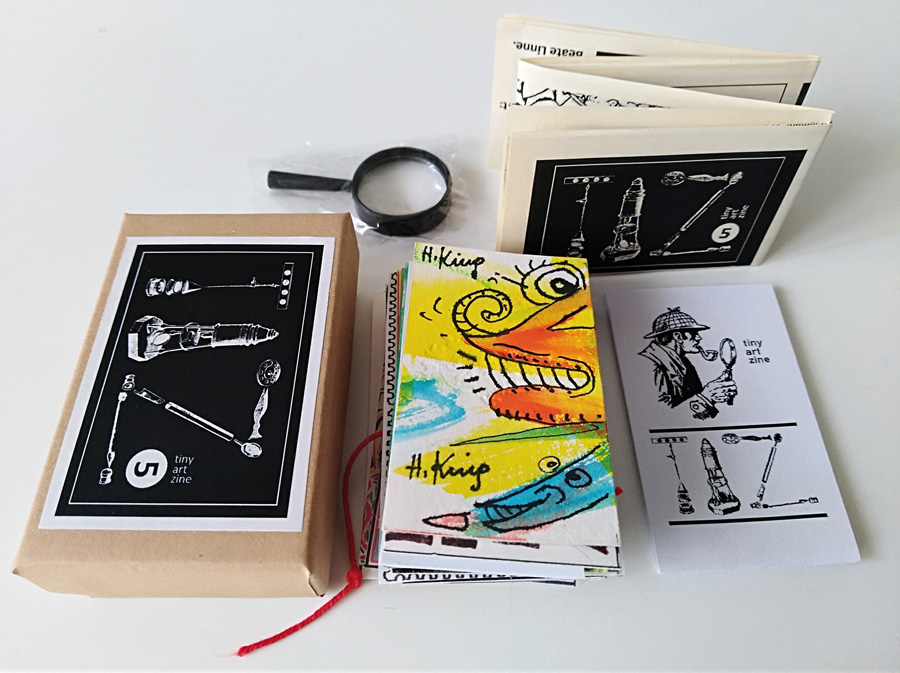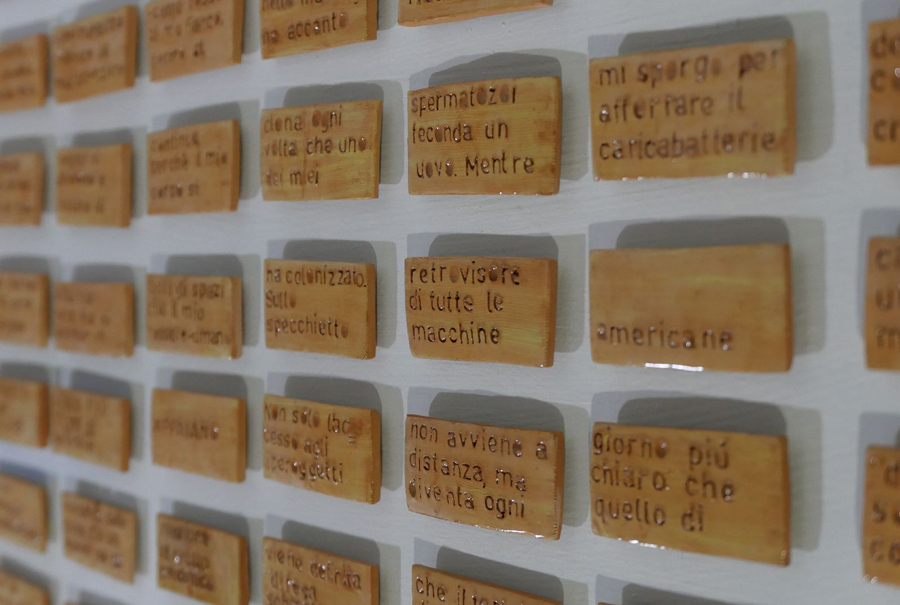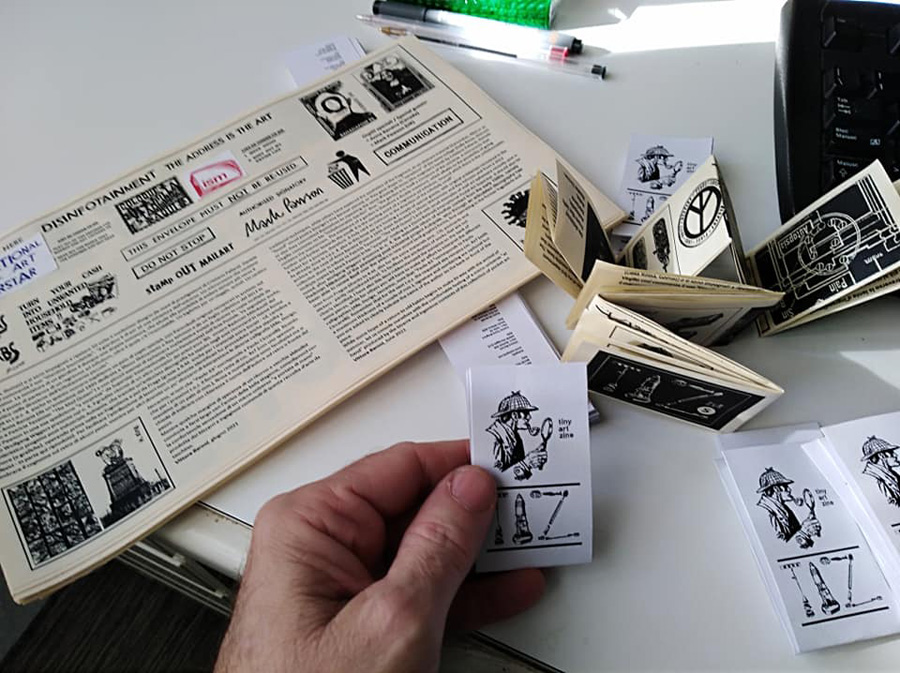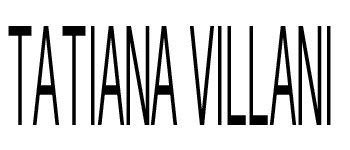T.A.Z. 5
Arte attraverso la lente d’ingrandimento

Eccoci già al quinto numero di questa rivista in miniatura, ad un ritmo che mi ricorda molto il mio primo esperimento di pubblicazione ad assemblaggio, Arte Postale!, la quale intorno al 1980 usciva in 100 copie a cadenza quasi mensile. L’alta e costante quantità di adesioni, a fronte di una promozione davvero minima, è un segno della curiosità e interesse che il concetto di miniaturizzazione continua a smuovere ed esercitare, non soltanto per scienziati, entomologi e collezionisti di francobolli. Il logo di copertina di t.a.z. 5, se ve lo doveste domandare, è stato composto combinando assieme parti di antichi microscopi, e anche stavolta trovate nel piccolo cofanetto una mini-lente d’ingrandimento, che spero possa essere di aiuto nel visionare i contributi trasformandovi in novelli Sherlock Holmes dell’arte, come gli attori Jeremy Brett e Basil Rathbone nelle foto qui sopra.
Tra autori divenuti ormai affezionate presenze e nuovi arrivi, anche questo numero di t.a.z. offre una ben variata miscela di micro-visioni provenienti da tre continenti e da una decina di diverse nazioni, facendo uso delle tecniche caratteristiche dell’arte postale (francobolli d’artista, timbri, collage) ma anche con arditi esperimenti materici, come la “anodigrafia” di Fausto Grossi, con intervento anodizzato su barretta di titanio (realizzata con materiali di scarto raccolti durante lavori di manutenzione al museo Guggenheim!) o come le preziose lastrine in ceramica create da Tatiana Villani, destrutturato cut-up di criptiche particelle testuali che unite assieme compongono una densa riflessione introspettiva ed ecologista. Come scrive l’autrice: “Il mio intervento nasce dalla lettura del testo Iperoggetti di Timothy Morton, in cui si parla di oggetti macroscopici di cui percepiamo solo frammenti e mai l’intero, come nel caso del cambiamento climatico. Allo stesso modo il testo inciso nella creta ci è visibile solo nella sua forma del frammento“.

Di natura concettuale e “organica” è anche l’opera dell’artista tedesca Beate Linne, che utilizzando i propri lunghi capelli ha scritto 50 volte la parola “unica”, dimostrando perizia e pazienza davvero certosina. Per non essere da meno, in ossequio al motto “la Poesia Visiva è dappertutto” ho provato a ricercare un flusso poetico all’interno di minuscole conchiglie, mescolato al familiare eco delle onde (per riuscire a percepirlo acusticamente, servirà un qualche tipo di amplificazione sonora, qui non fornita).
In t.a.z. 5 abbiamo opere che plaudono al concetto di “piccolo è bello” (Familiar) ma anche lavori “antagonisti” come lo slogan “ridicolizza le diverse forme di autorità” di Doriano Rota, o contributi influenzati dalla lunga emergenza del Covid 19 (il “mondo perduto” di David Dellafiora, il francobollo di Ptrzia TicTac, l’autoritratto pandemico di Fausto Grossi su adesivo, incluso in bonus in una trentina di copie), mentre nel suo pezzo “sciogli il nodo che ti lega alla corda” Maya Lopez Muro fornisce materiale e istruzioni per una liberatoria mini-performance fai-da-te. Vari autori si sono impegnati nel creare 50 pezzi fantasiosamente uno diverso dall’altro (King, Bolgiani, Jaccarino, Ciccarelli), tra acquerelli e tecniche tradizionali miste, mentre altri hanno esplorato l’estetica del frammento, come materia astratta (Zuromskas, Alle) o poesia visiva “trovata” (i pezzetti di letraset di Dorigo), oppure hanno dato forma a “variazioni” del medesimo collage (Della Rossa, Gomez) o si sono impegnati a ripetere 50 volte il medesimo disegno (le mani di prestigiatore di Cristiano Pallara). Daniele Virgilio così commenta il suo “Giardino insondabile“: “il giardino è di per sé una miniatura dell’universo. Un microcosmo che contiene il macrocosmo. La miniatura di un giardino è dunque una doppia miniatura, che allude alla possibilità di andare sempre più verso il piccolo: è il punto di partenza di un regressus ad infinitum, oltre il quale c’è l’insondabile. Un biglietto per un viaggio, quindi. Un santino come viatico nella direzione dell’infinitamente piccolo“.
Come già in t.a.z. 4, anche in questo numero ospitiamo un paio di ospiti speciali, con francobolli originali recuperati in archivio nel caso di Anna Banana (da un’emissione del 1995 dedicata a Shozo Shimamoto e Ray Johnson e da un foglio collettivo del 2013 in tributo a Patricia Tavenner “The Mail Queen”) e con piccoli esempi di ephemera mailartistica inviati di recente in copie multiple da Mark Pawson in una sua spedizione “a sorpresa” da Superstar Internazionale (Semi-Pensionata) dell’Arte Postale. Va segnalato anche, dopo Wolfgang Wiggers presente nel n. 4, il gradito ritorno di un altro contatto dei primi anni ’80, ovvero Radovan Milinkovi
del pionieristico progetto post-industriale Autopsia, che tramite un’articolata discografia ha saputo negli anni rinnovarsi in nuove forme sonore (e grafiche), operando prima nella ex-Yugoslavia e poi da Praga (grazie a R.M. anche per i materiali extra inviati – cd, cartoline e adesivi – in parte qui riprodotti). Per facilitare l’attribuzione di lavori non chiaramente identificati ho provveduto anche stavolta a timbrare il cognome sul retro di alcuni pezzi, mentre per altri dovrete un po’ sforzarvi di interpretare le diverse calligrafie (Alle, Dorigo, Jaccarino, si noti che “Paolo 63” corrisponde a Paolo Ciccarelli). Ricordo che per i prossimi t.a.z. il formato resta di cm. 4×7 (con uno spessore massimo di un paio di mm.), firma e numerazione sono facoltativi ma si chiede di indicare con chiarezza il nome dell’autore sul retro o fronte del pezzo.
Mentre qualche margine di speranza di un ritorno a vecchie abitudini comincia a farsi largo con l’arrivo della bella stagione, consoliamoci con la confortevole sensazione di un micro-universo “a portata di mano” prodotta dai bizzarri e ingegnosi contenuti di questa raccolta d’arte da taschino.
Vittore Baroni, giugno 2021

Art through the magnifying glass
Here we are already at the fifth issue of this miniature magazine, at a pace that reminds me a lot of my first experiment with an assembling publication, Arte Postale!, which around 1980 came out in 100 copies on an almost monthly basis. The high and constant amount of adhesions, in the face of a very minimal promotion, is a sign of the curiosity and interest that the concept of miniaturization continues to stir and exercise, not only for scientists, entomologists and stamp collectors. The cover logo of t.a.z. 5, if you were wondering, was composed by combining parts of ancient microscopes together, and once again you will find in the small box a mini-magnifying glass, which I hope will be of help in viewing the contributions by transforming you into novel Sherlock Holmes of the art, like the actors Jeremy Brett and Basil Rathbone pictured above.
Between loyal authors who have become constant presences and new collaborators, this issue of t.a.z. offers a varied blend of micro-visions from three continents and a dozen different nations, making use of the typical techniques of mail art (artist’s stamps, rubberstamps, collages) but also with daring experiments on different materials, such as the “anodigraphy ” by Fausto Grossi, with anodized intervention on a titanium bar (made with waste materials collected during maintenance work at the Guggenheim museum!) or as the precious ceramic plates created by Tatiana Villani, deconstructed cut-up of cryptic snippets of text that joined together compose a dense, introspective and ecological statement. As the author writes: “My intervention stems from the reading of the text Iperoggetti by Timothy Morton, which speaks of macroscopic objects of which we perceive only fragments and never the whole, as in the case of climate change. Likewise the text. engraved in the clay, is visible to us only in its fragment form“.

Of a conceptual and “organic” nature is also the work of the German artist Beate Linne, who using her long hair wrote the word “unica” (“unique”) 50 times, demonstrating truly painstaking skill and patience. Not to be outdone, in accordance with the motto “Visual Poetry is everywhere” I tried to search for a poetic flow inside tiny shells, mixed with the familiar echo of the waves (to be able to perceive it acoustically, some kind of sound amplification will be needed, not provided here).
In t.a.z. 5 we have works that applaud the concept of “small is beautiful” (Familiar) but also “antagonistic” works such as the slogan “ridicule the different forms of authority” by Doriano Rota, or contributions influenced by the long emergency of Covid 19 (the “lost world” by David Dellafiora, the Ptrzia TicTac postage stamp, Fausto Grossi’s pandemic self-portrait on sticker, included as a bonus in about thirty copies), while in his piece “untie the knot that binds you to the rope” Maya Lopez Muro provides materials and instructions for a liberating DIY mini-performance. Several authors have undertaken to create 50 pieces each imaginatively different from the other (King, Bolgiani, Jaccarino, Ciccarelli), using watercolors and mixed traditional techniques, while others have explored the aesthetics of the fragment, as an abstract material (Zuromskas, Alle) or as “found” visual poetry (Dorigo‘s tiny letraset pieces), or they gave shape to “variations” of the same collage (Della Rossa, Gomez) or else they committed themselves to repeating the same drawing 50 times (the magician’s hands by Cristiano Pallara). Daniele Virgilio comments on his “Unfathomable Garden” thus: “the garden is in itself a miniature of the universe. A microcosm that contains the macrocosm. The miniature of a garden is therefore a double miniature, which alludes to the possibility of going further and further towards the small: it is the starting point of a regressus ad infinitum, beyond which there is the unfathomable. A ticket for a journey, therefore. A holy card as viaticum in the direction of the infinitely small“.
As already done in t.a.z. 4, also in this issue we are hosting a couple of special guests, with original artistamps recovered in the archive in the case of Anna Banana (from a 1995 sheet dedicated to Shozo Shimamoto and Ray Johnson and from a 2013 collective sheet in tribute to Patricia Tavenner “The Mail Queen”) and with small examples of mail art ephemera recently sent in multiple copies by Mark Pawson in his “surprise” mailing as a (Semi-Retired) International Postal Art Superstar. It should also be noted, after Wolfgang Wiggers‘ presence in n. 4, the welcome return of another contact from the early 1980s, namely Radovan Milinković of the pioneering post-industrial project Autopsia, who through an articulated discography has been able to renew itself over the years in new sound (and graphic) forms, first operating in the former Yugoslavia and then from Prague (thanks to R.M. also for the extra materials sent – CD, postcards and stickers – partly reproduced here). To facilitate the attribution of works that are not clearly identified, I have also this time rubberstamped the surname on the back of some pieces, while for others you will have to make an effort to interpret the different calligraphies (Alle, Dorigo, Jaccarino, note that “Paolo 63 “corresponds to Paolo Ciccarelli). Remember that for the next t.a.z. the requested size remains cm. 4×7 (with a maximum thickness of a couple of mm.), signature and numbering are optional but you are asked to clearly indicate the name of the author on the back or front of the piece.
While some hope of a return to old habits begins to make its way with the arrival of summer, let us console ourselves with the comfortable feeling of a micro-universe “at hand” produced by the bizarre and ingenious contents of this collection of pocket art.
Vittore Baroni, June 2021
